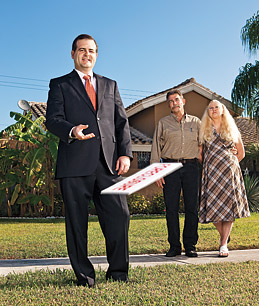
If you think subprime lenders are the loan sharks of real estate, then loan servicers–the outfits that collect mortgage money and run the books–are the enforcers. Their job is to keep the dough coming, no matter what. Yet Ocwen, one of the nation’s largest servicers of subprime loans, has rewritten its role as the heavy and may have an approach to modifying delinquent loans that could slow the wave of foreclosures undermining the economy. Last year, nearly a million houses were lost to foreclosure. That number could easily rise by millions over the next few years, promising more economic pain. The big problem is that no one has figured out a systematic way to stop the rot. Federal agencies and private lenders have rolled out one loan-modification program after another–scattershot and largely timid attempts to make existing mortgages more affordable and keep neighborhoods intact. Then there is Ocwen, which has already revised 16% of its 340,000 mortgages, in many cases cutting monthly payments 20% to 40%. Based in West Palm Beach, Fla., the company handles some of the worst loans Wall Street kicked up during the housing boom and isn’t about to win any popularity contests among consumers–in the past, it’s been the target of complaints about unresponsiveness and excessive fees. Nevertheless, good ideas can come from unlikely places, and as more borrowers–including a growing number with prime loans–fall behind on payments, there are lessons to be learned from the firm that has done more than almost anyone else to keep struggling homeowners in their houses. Executives at Ocwen used to think, as those at any mortgage servicer would, that the solution to a delinquent loan was to create a plan for homeowners to catch up on past payments. When house prices were rising and refinancing was easy, that generally worked, even though it often meant higher monthly payments. But in early 2007, as housing values plateaued, then plummeted, Ocwen saw the percentage of homeowners defaulting a second time climb from 25% to 36%. “We realized we were going to have to make some adjustments,” says Ocwen president Ron Faris. So the company reprogrammed its computer models, which determine how to extract the most value from each loan, to allow much more substantial changes–lowering a mortgage’s interest rate, docking its principal balance, converting an adjustable rate to a fixed one, stretching out the life of a loan. With many mortgages “upside down”